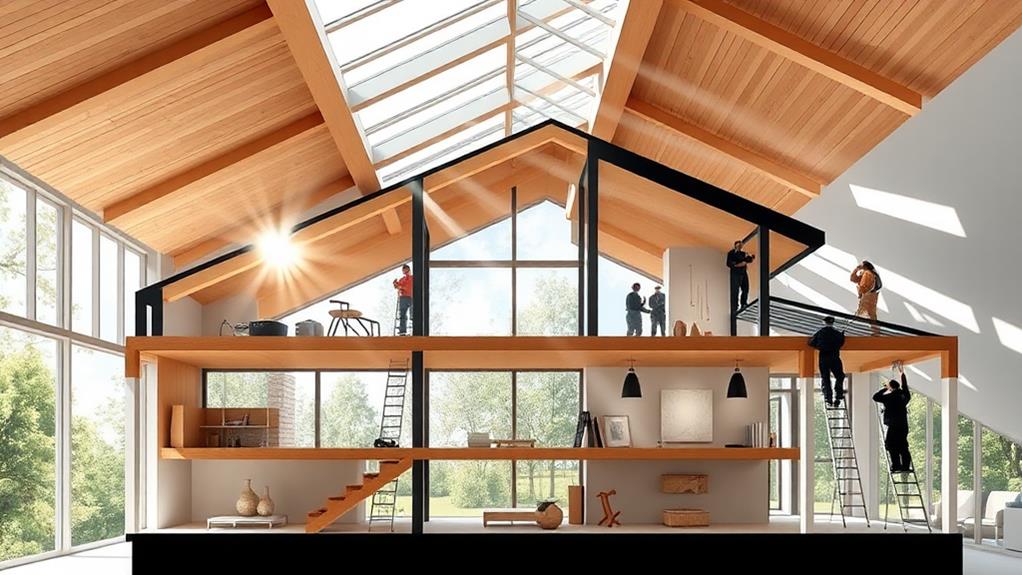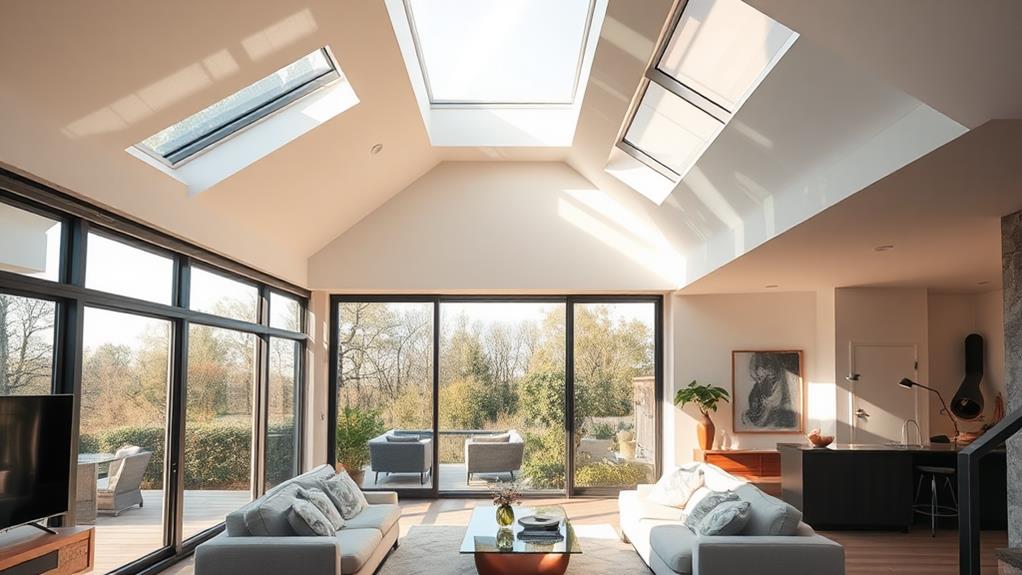Skylights and sun tunnels offer different approaches to bringing natural light into your home. Skylights provide larger openings and ventilation options but can affect energy efficiency due to heat transfer. Sun tunnels, with their smaller, tubular design, are generally more energy-efficient and easier to install. Both options can reduce your reliance on artificial lighting, potentially lowering energy bills by 10-15%. When choosing between the two, consider your home's layout, local climate, and energy efficiency goals. Modern technologies like smart controls and improved materials have enhanced the performance of both skylights and sun tunnels. Exploring these options further can help you make an informed decision for your home.
Understanding Skylights and Sun Tunnels

Many homeowners are familiar with skylights, but fewer know about sun tunnels. Skylights are windows installed on roofs, allowing natural light to enter directly from above. They're typically larger and can be opened for ventilation.
Sun tunnels, also called tubular skylights or solar tubes, are smaller, cylindrical structures that channel light from the roof to the ceiling below.
Skylights offer a broad view of the sky and can significantly brighten a room. They're ideal for spaces where you want abundant natural light and a connection to the outdoors. Sun tunnels, on the other hand, are more discreet and flexible. They use reflective tubing to funnel light through attics or between floors, making them suitable for areas where traditional skylights aren't practical.
Both options can reduce your reliance on artificial lighting, potentially lowering energy costs. However, they differ in installation complexity and impact on your home's insulation. Skylights require more extensive roof modifications and can affect your home's thermal envelope. Sun tunnels, being smaller, typically have less impact on insulation and are easier to install, especially in existing structures.
Energy Efficiency Comparison
When you're considering skylights or sun tunnels, energy efficiency should be a top priority. Both options can impact your home's energy consumption, but they do so in different ways.
Skylights typically offer larger openings, allowing more natural light to enter your space. However, this can lead to increased heat gain in summer and heat loss in winter. Modern skylights often feature low-E coatings and double or triple-pane glass to mitigate these issues. You'll find that skylights with operable vents can help regulate temperature and improve air circulation.
Sun tunnels, on the other hand, are generally more energy-efficient due to their smaller size and tubular design. They minimize heat transfer and provide consistent light distribution throughout the day. The reflective material inside the tube helps maximize light transmission while reducing heat gain. You won't get the same expansive view as with skylights, but sun tunnels excel in delivering natural light to interior spaces without compromising energy efficiency.
When comparing the two, consider your specific needs. If you're looking for maximum light and ventilation, skylights might be your best bet. For focused, energy-efficient lighting in smaller or interior spaces, sun tunnels offer an excellent solution.
Design and Installation Considerations

Design and installation considerations for skylights and sun tunnels go beyond just choosing between the two options. You'll need to carefully assess your home's structure, roof pitch, and local climate.
For skylights, consider the room's layout and function to determine optimal placement. Sun tunnels offer more flexibility, especially for rooms without direct roof access.
When installing skylights, you'll need to ensure proper flashing and sealing to prevent leaks. Choose energy-efficient, double or triple-paned glass with low-E coatings to minimize heat transfer.
For sun tunnels, select the appropriate tube diameter and length to maximize light transmission. Consider flexible tubes for challenging installations around obstacles.
Don't forget about local building codes and permits. You may need professional installation, particularly for skylights, which require cutting into your roof structure. Factor in ongoing maintenance, such as cleaning and potential repairs.
For both options, consider adding motorized blinds or shades to control light and heat gain.
Lastly, think about your home's exterior aesthetics. Skylights are more visible from the outside, while sun tunnels have a lower profile. Choose designs that complement your home's architectural style for a seamless integration.
Latest Technologies and Innovations
The world of skylights and sun tunnels has seen remarkable advancements in recent years. You'll find cutting-edge technologies that enhance energy efficiency and light control. Smart skylights now integrate with home automation systems, allowing you to adjust their transparency or open and close them remotely. Some models even feature built-in sensors that react to weather conditions, automatically closing during rain or adjusting tint to reduce heat gain.
Sun tunnels have also evolved, with improved reflective materials that maximize light transmission. You can now choose from flexible or rigid tubes, depending on your installation needs. LED-integrated sun tunnels provide illumination even at night, seamlessly transitioning from natural to artificial light.
Photovoltaic skylights combine daylighting with solar energy generation, contributing to your home's power needs. Advanced glazing technologies, such as electrochromic glass, allow you to control the amount of light and heat entering your space with the touch of a button. Low-E coatings and gas-filled double or triple-pane skylights offer superior insulation, reducing heat loss in winter and heat gain in summer. These innovations help you maximize natural light while maintaining energy efficiency in your home.
Cost-Benefit Analysis

Investing in skylights or sun tunnels requires careful consideration of both costs and benefits. Initial installation expenses can range from $500 to $3,000 per unit, depending on size, type, and complexity. You'll also need to factor in potential roof modifications and interior finishing work.
On the benefits side, these installations can significantly reduce your reliance on artificial lighting, potentially saving 10-15% on energy bills. They'll also increase your home's natural light, which can boost property value by 1-3%. Improved daylighting has been linked to enhanced mood, productivity, and overall well-being.
However, you must weigh these advantages against potential drawbacks. Skylights may lead to heat gain in summer and heat loss in winter, affecting your HVAC costs. Sun tunnels, while more energy-efficient, provide less direct light and view compared to traditional skylights.
To maximize your return on investment, consider your climate, roof structure, and specific lighting needs. Opt for energy-efficient models with low-E coatings and proper insulation. Regular maintenance is crucial to prevent leaks and ensure longevity. By carefully analyzing these factors, you can determine if skylights or sun tunnels are a cost-effective solution for your home.
Environmental Impact Assessment
While skylights and sun tunnels can enhance your home's natural lighting, it's crucial to consider their environmental impact. These installations affect your home's energy consumption and carbon footprint in several ways.
On the positive side, they reduce your reliance on artificial lighting, lowering electricity usage and associated greenhouse gas emissions. They can also provide passive solar heating in winter, potentially decreasing your heating costs and fossil fuel consumption.
However, skylights and sun tunnels may compromise your home's insulation, leading to increased heat loss in winter and heat gain in summer. This can result in higher energy use for heating and cooling. The manufacturing and transportation of these products also contribute to their overall environmental impact.
To minimize negative effects, choose energy-efficient models with high insulation values and low-emissivity coatings. Consider the placement carefully to maximize benefits while minimizing heat transfer issues. Opt for recyclable materials when possible, and ensure proper installation to prevent air leaks.
Conclusion
As you weigh your options, remember that skylights and sun tunnels are more than just windows to the sky. They're your ticket to a brighter, more energy-efficient future. Like a ray of hope piercing through clouds, these innovations can transform your space. So, don't let the opportunity slip through your fingers. Embrace the light, balance the benefits, and let your home bask in the warm glow of natural illumination and energy savings.

